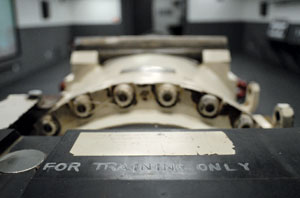Five-and-a-half years ago, the four founders of Nomad Technologies, Inc., were recent college grads working summers as raft guides in Montana. Today, they’ve built Nomad into a thriving, multi-million dollar company producing specialized mobile command vehicles for emergency response crews and the military.
As guides, the four friends would double as bus drivers when fires flared up in the area, transporting supplies and firefighters. They noticed a frequent complication at the fire camps: Because of the remote locations, firefighters had difficulty communicating with off-site commanders.
It was a problem the technically savvy group knew they could fix.
The three Kalispell natives and an Idaho transplant quit rafting and started a remote communications company together, leasing high-tech trailers to the U.S. Forest Service. Their first office was two guest bedrooms and a barn at a friend’s house.
 |
|
Elisabeth Young exits one of two new U.S. Army mobile classrooms engineered and built by Nomad Technologies. |
Since then, the company’s founders – Shane Ackerly, brothers Will and Seth Schmautz, and Clay Binford – are even amazed at the growth. “Someone pointed out to me that our old facility was smaller than just the entryway of this location,” Will Schmautz, Nomad’s President and CEO, said.
The current location is the company’s fifth – a 35,000 square-foot warehouse near Glacier International Airport. Nomad Technologies now sells and leases its mobile communication vehicles, and the 26-employee company has nearly doubled its production every year since its inception. Two weeks ago, Nomad unveiled its largest project to date at an open house: two mobile training facilities for the U.S. Army.
While Nomad still partners the Forest Service – Nomad vehicles assisted in fires from Florida to California last year – its clientele has expanded to include U.S. Fish, Wildlife and Parks, the U.S. Department of Homeland Security and city and county agencies across the country. “Eighty to 90 percent of our work comes from government agencies,” Binford said.
Their plans show they want to push further.
Binford, the company’s vice president of marketing and sales, said the company plans another, secondary location to serve the south and east regions of the country where Nomad’s business is booming. He says they expect to employ 40 people by the end of the year, and rattles off a list of private companies that could use Nomad’s services. Nomad, he hopes, will become the Department of Homeland Security’s main supplier for emergency command vehicles within five years.
“There are some challenges that come with this much growth, but we’re simply blessed to be where we are today,” Binford said.
The founders are happy they’ve been able to keep their growing business in the Flathead Valley, adding jobs to the local economy. When they outsource, they try to use local industries. “There’s a hard work ethic here, and a lot of cottage industries that do amazing work,” Binford said. And, it doesn’t hurt that being in Montana adds a certain mystique to their business, and an enticing vacation spot for interested clients.
 |
|
“For Training Only,” is etched on across the metal of the M1A2 Abrams gun assembly that is permanently installed in the new U.S. Army mobile classroom vehicle built and engineered by Nomad Technologies, Inc. |
There’s also a lot of satisfaction knowing that, even though they may not be on the front lines helping when natural disaster strikes, their vehicles are. At the recent open house, U.S. Army Maj. Chris Cavin said Nomad’s classrooms would increase the number of soldiers he’s able to train while decreasing a soldier’s time away from home.
“All the little stuff when a guy comes back cuts away at that leave time,” he said. “If I can go to them and they can go home to their wife and kids after training, that’s better for everyone.”
Despite warnings against working with friends, Nomad’s founders remain close. “As friends, we trust each other more and we all know where we’ve come from, what’s made this happen,” Binford said.